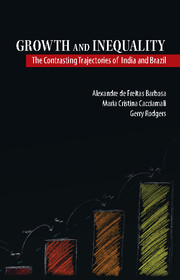Book contents
- Frontmatter
- Contents
- List of Tables
- List of Graphs and Maps
- Preface and Acknowledgements
- List of Abbreviations
- 1 Brazil and India: A Mirror Image of Each Other?
- 2 Approach and Method
- 3 Brazil and India in the Decades before 1980
- 4 India and Brazil from 1980 until 2014
- 5 Key Divides and Cleavages: Ruptures, Continuities, or Adaptation?
- 6 Inequality in Social and Economic Context
- 7 Post-Script
- Bibliography
- Index
4 - India and Brazil from 1980 until 2014
Published online by Cambridge University Press: 02 August 2019
- Frontmatter
- Contents
- List of Tables
- List of Graphs and Maps
- Preface and Acknowledgements
- List of Abbreviations
- 1 Brazil and India: A Mirror Image of Each Other?
- 2 Approach and Method
- 3 Brazil and India in the Decades before 1980
- 4 India and Brazil from 1980 until 2014
- 5 Key Divides and Cleavages: Ruptures, Continuities, or Adaptation?
- 6 Inequality in Social and Economic Context
- 7 Post-Script
- Bibliography
- Index
Summary
Chapter 4 pursues the approach adopted in Chapter 3 for the period from 1980 to 2014. In the first section, a broad overview of the period is provided for both countries. It connects the political context (the political timeline in Table 4.1.1) with economic policies in the light of the changing growth regimes. The following sections of the chapter successively consider the macro-economics of accumulation and growth (4.2); labour institutions and labour markets (4.3); and the role of the state (4.4), relating them all with the outcomes in terms of inequality.
Political Context, Economic Policies, and Growth Regime
By the end of 1970s, with the global economy in deep crisis and the exhaustion of the Fordist growth regimes in developed countries, both Brazil and India faced turbulent times. In the 1980s, the rise in international interest rates led to a sharp contraction of world trade and a debt crisis in some countries of the periphery, mostly in Latin America and Africa. Growth rates fell around the world, and economic institutions were restructured to serve the interests of the increasingly globalized private sector, especially TNCs and major financial groups, providing the foundations for the subsequent phase of deregulated globalization.
Given the histories of the two countries up to that point, it would seem that Brazil's economy was better placed to face the turbulence. After all, despite weaknesses in the late 1970s, thirty years of high growth in Brazil had laid the foundations of a powerful industrial economy. Meanwhile, India had faced both economic and political crisis with a model that was delivering declining rates of growth and stagnant living standards. But the result was the opposite: India embarked on a period of increasing growth, while Brazil found itself mired in the ‘lost decade’.
In fact, Brazil's ‘success’ was related to its deep integration into the capitalist world economy of the 1960s and 1970s. This can be characterized as subordinated integration, as the country opened its internal market to TNCs and became deeply indebted to commercial banks by taking loans with floating interest rates. In the new context, Brazil's industrial sector was hard hit and the public sector severely affected by the sharp increase in foreign debt. In India, the external crisis was much less intense, largely because the country's ties to the global economy were weaker.
- Type
- Chapter
- Information
- Growth and InequalityThe Contrasting Trajectories of India and Brazil, pp. 85 - 186Publisher: Cambridge University PressPrint publication year: 2017



